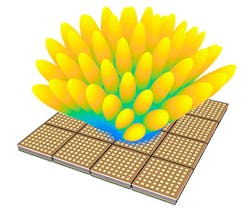Millimeter-wave frequencies have attracted the interest of system designers of automotive collision-avoidance radar systems and 5G wireless communications networks. They have also now gained the attention of planners at DARPA seeking advanced secure communications techniques, who have announced the launch of the Millimeter-Wave Digital Arrays (MIDAS) program. This initiative will develop element-level digital phased-array technology that will enable next-generation Department of Defense (DoD) millimeter-wave systems.
The program is geared toward finding a common digital array tile for performing multiple-beam directional communications at millimeter-wave frequencies. The plan is to move mobile military communications to the millimeter-wave frequency region (above 30 GHz), with research focusing on reducing the size and power consumption of digital millimeter-wave transceivers. The use of element-level digital beamforming in phased-array antennas has made it possible to use multiple receive and transmit beams in multiple directions simultaneously to reduce node discovering time and improve network throughput.
An artist’s concept portrays an antenna array tile for phased-array communications that will allow multiple-beam directional communications at millimeter-wave frequencies. (Courtesy of DARPA)
Researchers pursuing short-range, “last mile” large-capacity data links for 5G wireless communications networks are already investigating the use of phased-array antenna technologies for these links at millimeter-wave frequencies. The DoD applications would be considerably more complex, since the systems to communicate are often moving in three dimensions with much different orientations. The nature of DoD communications requirements creates unique beamforming challenges for phased-array antennas working in multiple-beam communications systems.
“Imagine two aircraft both traveling at high speed and moving relative to one another,” explains DARPA program manager Timothy Hancock. “They have to find each other in space to communicate with directional antenna beams, creating a very difficult challenge that can’t be solved with the phased-array solutions emerging in the commercial marketplace.”
Current digital beamforming arrays at lower frequencies are quite large, and so DARPA seeks to move to the smaller wavelengths of millimeter-wave frequencies to help miniaturize millimeter-wave communications systems. “Through MIDAS, we are seeking proposals that combine advances in millimeter wave and digital beamforming technologies to create radios that will deliver secure communications for our military,” said Hancock.
The four-year MIDAS program is focused on two key technical areas: the development of the silicon integrated circuits (ICs) needed for the core transceiver of the array tile; and the development of wideband antennas, millimeter-wave transmit/receive (T/R) components, and the integration of the various components needed to enable the use of this millimeter-wave technology across a number of different applications. Anticipated applications include tactical line-of-sight communications as well as satellite communications (satcom).


